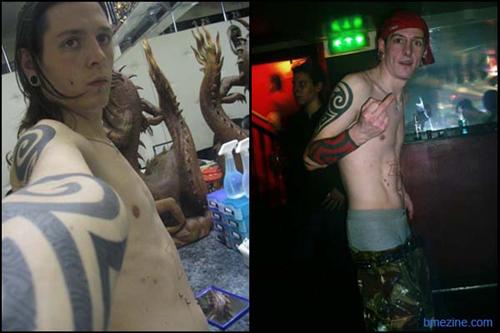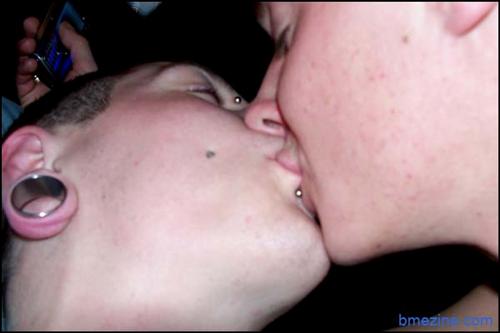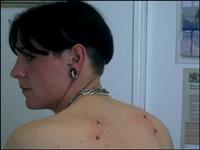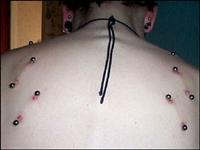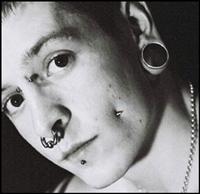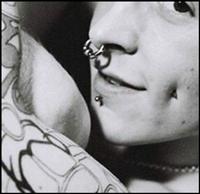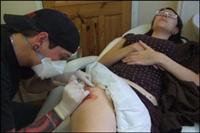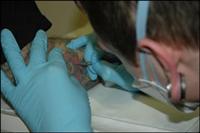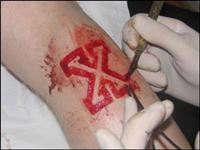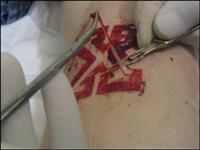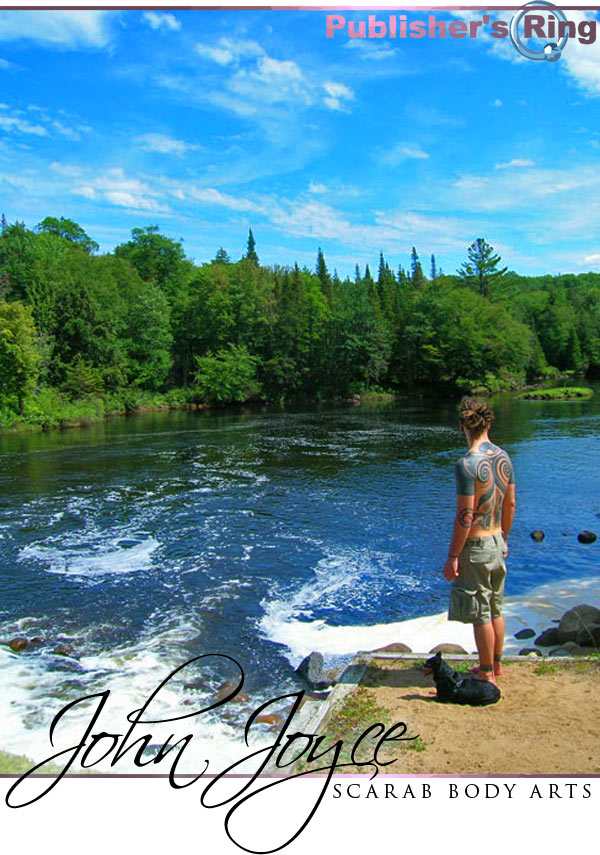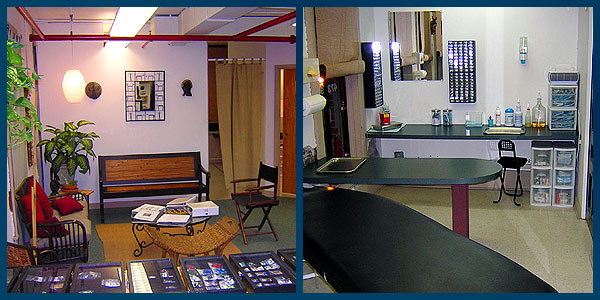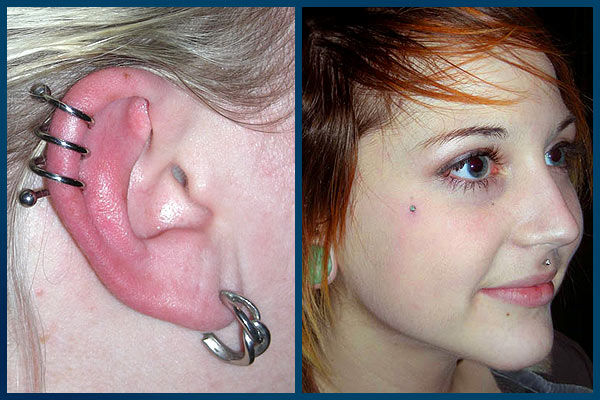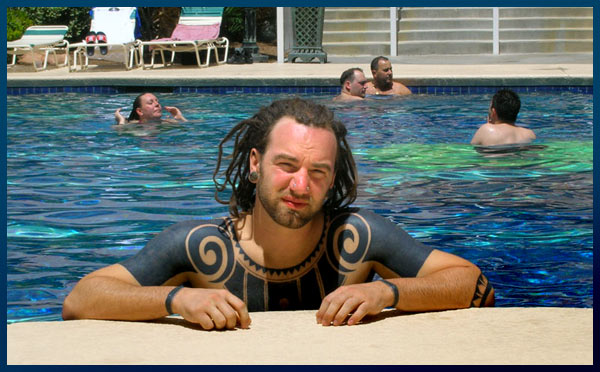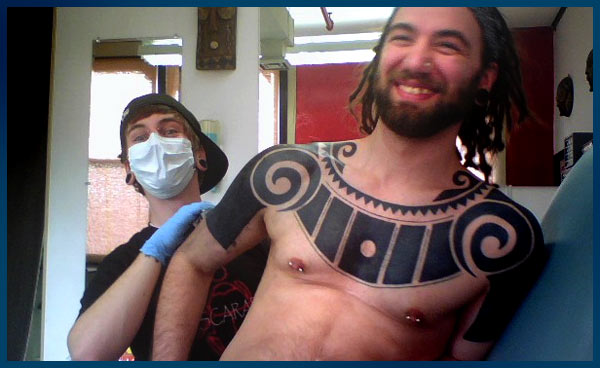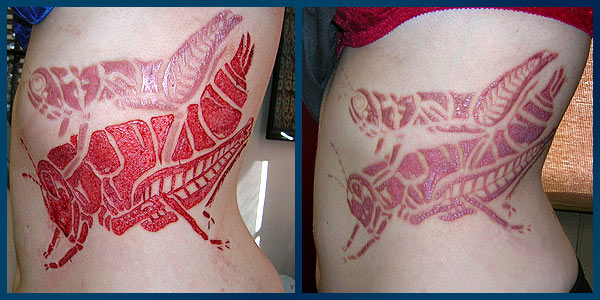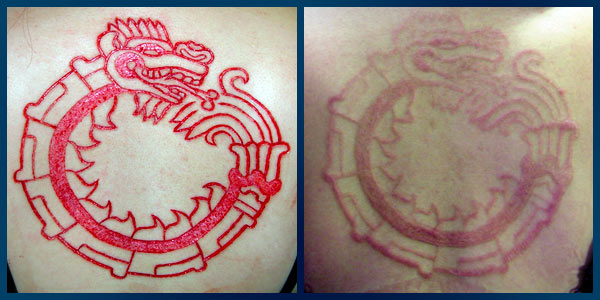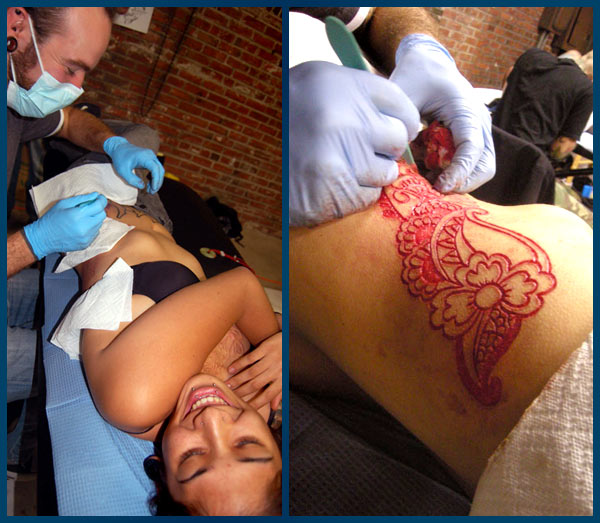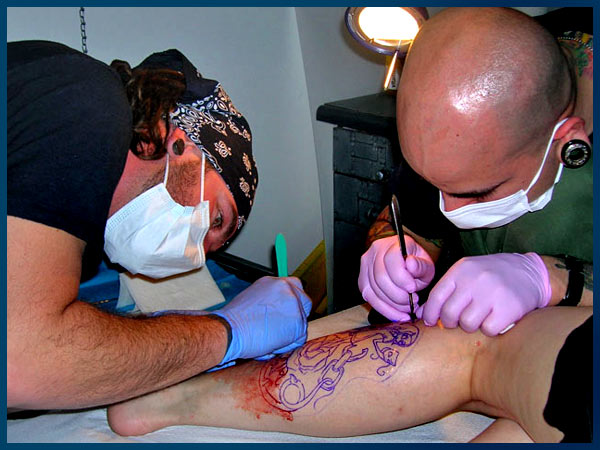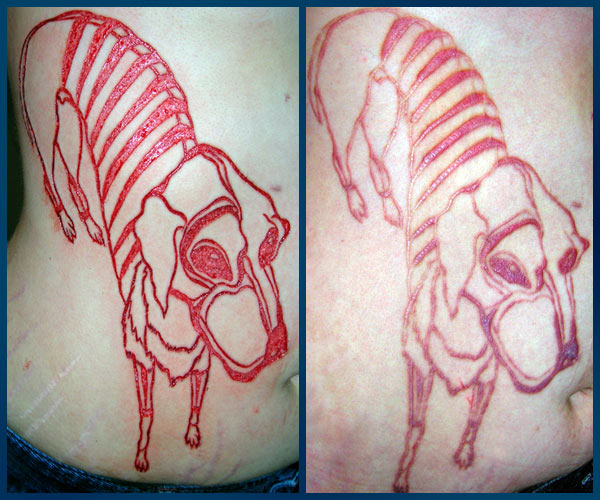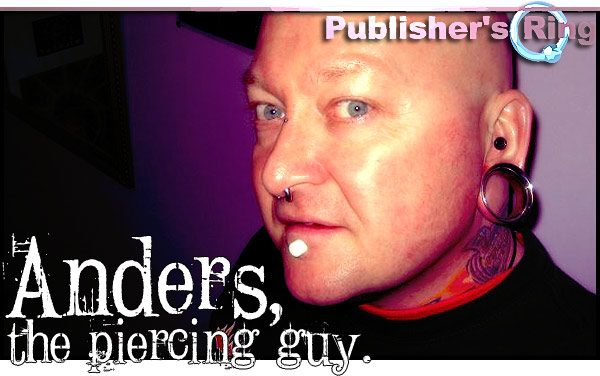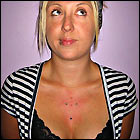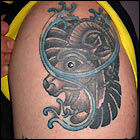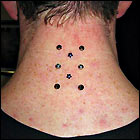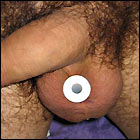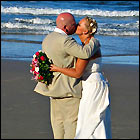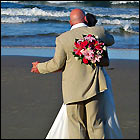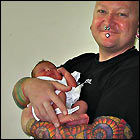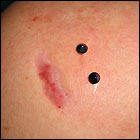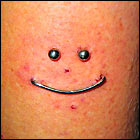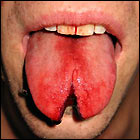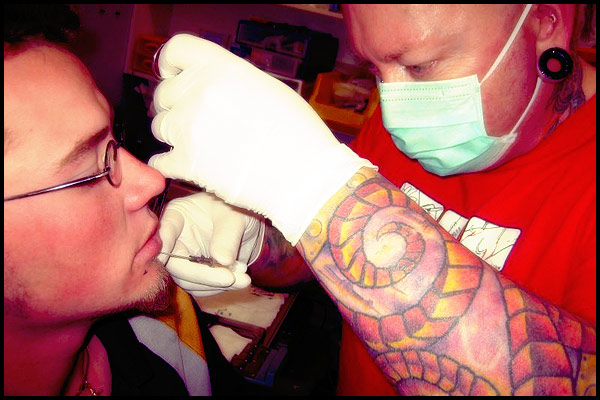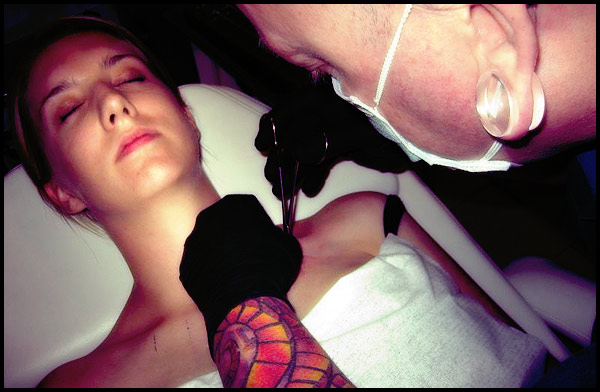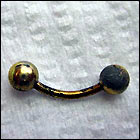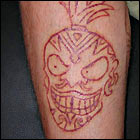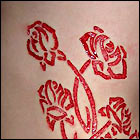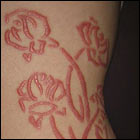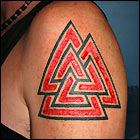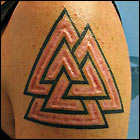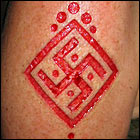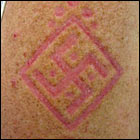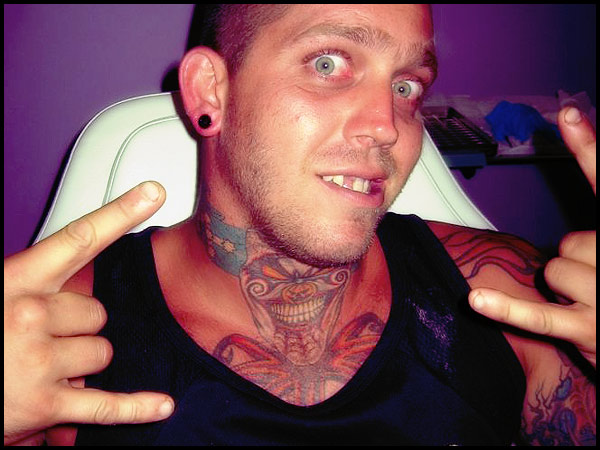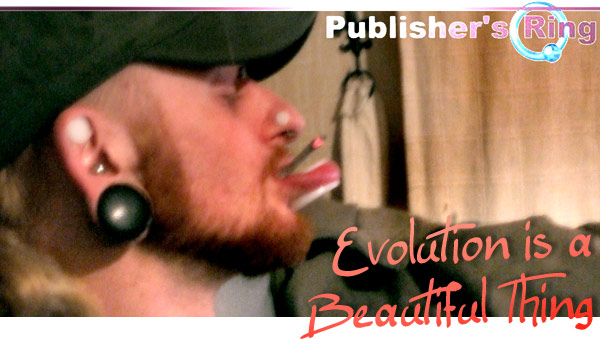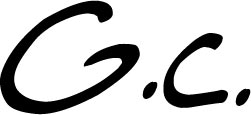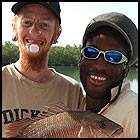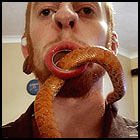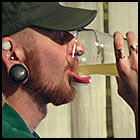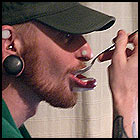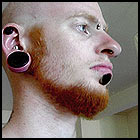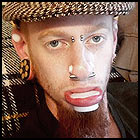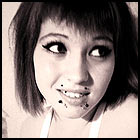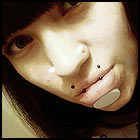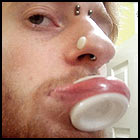He is the Diddy Man, the poking, cutting Diddy Man, but he doesn’t come from Knotty Ash!
I tried to write an introduction somehow comparing Diddy to Oliver Twist, but unfortunately there are no similarities.
However, if you’d like to read about the life, past, hopes and dreams of an up-and-coming scarification artist from Blighty who’s battling with a lifelong passion for piercing people, don’t let me stop you! (just don’t ask for more, please)

|
ROO: |
Tell me a little about your personal history (your age, childhood, education, all that jazz)
|
|
DIDDY: |
Well, I’m 23, I live in Bournemouth, England now and have been living here for the last 6 or 7 years. I was born in Grimsby and lived in the Netherlands until I was about 5 or 6, then I moved to a small town just outside of Oxford where I went to school. It was a bit of a closed community and everybody knew everybody else, so nothing much ever happened there…
|
|
ROO: |
I know the feeling! So, know we know a little about when you were little, tell me a little about your professional history (both in modification, and before that if you had a “previous career”)?
|
|
DIDDY: |
I had always pierced as a hobby back in school I was always piercing myself and friends (ridiculously badly with bits and pieces bought from the Internet), looking back on it I realise now how badly I was actually doing things. In the time since I left school though I have worked in a newsagents, been a storesman, worked in a paper-mill binding magazines, various pubs and clubs, and even worked for the MOD for a while on a fueling station, I completed two years of a three year course in vehicular mechanical and electronic systems, but decided it really wasn’t what I expected it to be and moved onto something else. I think the most memorable of all of them though has to be working for Bournemouth’s prestigious ‘Royal Bath Hotel’ as a bell boy, blue and gold waistcoat, full piercings and 25mm lobes, the works! I think somewhere is a couple of pictures as proof. Needless to say that didn’t last long. It kind of ended when the question was asked ‘What disease is it that makes those holes in your ears?’ They actually fired me when I told them it wasn’t a disease and I had stretched them myself. I suppose my professional career really started when I was offered the desk/cleaning job at Metal Fatigue in Bournemouth town centre with Sarge, he showed me how to deal with customers correctly, taught me about hygiene and sterility and at the same time introduced me to BME, the rest as they say, is history.
|
|
ROO: |
You’re history! Sorry, ignore that.. So, how do people get in touch with you and where do you work right now?
|
|
DIDDY: |
I’ve worked from White Flame since I left Metal Fatigue back in 2003; it was an opportunity to work for myself. Do my own thing and wave my own banner, so to speak. It was something I always dreamed of doing but never EVER thought I’d have the opportunity to do. I was just lucky that I had worked at Metal Fatigue, being one of the busiest body piercing clinics in the UK, I got to do a lot of piercing and fixing and dealing with issues and problems coming from other studios. I gained a wealth of experience from that place for which I will always be grateful and never forget. I can be contacted via the shop, or the website www.whiteflameltd.co.uk or through my IAM page.
|
|
ROO: |
To what extent does your sexuality play into your body modification interests? If you don’t mind talking about it, I understand that you didn’t come out until quite late in life?
|
|
DIDDY: |
I like to think that my sexuality has no effect on my professional life, of course it means that ladies are a little more trusting with their genital piercings. And I seem to do a hell of a lot of PA’s and paired nipples on 40-something guys that have seen me out and about on the scene, I suppose I’m an approachable friendly young man more than a ‘gay’ and that’s the way I like it. I would hate to think that anyone would be put off by it, usually most customers don’t even know unless they know someone that I’ve talked to or know me personally.
|
|
ROO: |
When did you first become aware of piercing?
|
|
DIDDY: |
I suppose I’ve always been aware of piercing, it’s the era we live in, when people don’t have to be formally introduced to it to know what it’s all about, there is just an awareness of it from a really young age. I don’t know if this is how others are but that’s just the way it’s always been for me. But you could say that friends and people you look up to having them is one of the biggest contributing factors in deciding whether or not it’s something you like.
|
|
ROO: |
My first nostril piercing was mostly due to Slash from Guns and Roses, I loved him but he never called. Tell me about your first piercings and what got you into being a pierced person?
|
|
DIDDY: |
It all started as a bit of a bet, I purposely lost to make an excuse to go and get my nipple pierced. I was meant to ask a someone out on a date or go get my nipple pierced. I was fourteen at the time and it was back when leaving school for lunch meant you were old enough to have this kind of thing done. Needless to say, I got the piercing. I had a few friends there with me, the guy was waffling on about how he knew exactly what he was doing and how he knew better than everybody else in the industry about how things should be done, (looking back on it now I realise he was just a back alley piercer doing a botch job) but at the time he was my hero, his name was Terry, he did my first piercing and I loved it, he had a tattoo on his head, I thought he was ‘Sooo cool!’ (jeez I was a very naive young boy). I ended up spending most of my lunchtimes in the parlor watching tattoos being done, fetching sandwiches for the piercer and his mates, I loved just being a part of it. I ended up with both nipples, eyebrow, tragus, two in my tongue. Back then I was one of the most heavily pierced guys in our little closed community. So when I turned up at the doors of Metal Fatigue for my first piercings in Bournemouth I was in heaven. I realised that so much more was possible, there was surface work available as well as so many piercings I had never seen before. A small selection of Diddy’s torso piercings, from over the years. (click-throughs)
|
|
ROO: |
What made you want to become a professional piercer? How did you start piercing people?
|
|
DIDDY: |
I had been doing botch piercings for a long time, working on my friends and such back in school through college and a few years before I started at Metal Fatigue. I’ve always been one of those guys that was never very good at anything, yet piercing just felt natural to me. I was pretty good at it and it pleased me to see that I could do something well and that kind of encouraged me into working it into a career.
|
|
ROO: |
What do your family think about your job?
|
|
DIDDY: |
My family still come from the same closed community I keep mentioning and all think I’m a little weird, but I’ve surprised them a few times over the years and I think they see it as just another one of my quirks. My whole family though is very supportive of me and what I do, they can see that I am working hard pushing my career and what I do, and they obviously see that I’m doing a good thing for myself. They usually make comments on the piercings that I wear, whether they do or don’t like them, but at the end of the day my appearance doesn’t really have any effect on my choice of career now so they really take it all in their stride.
|
|
ROO: |
Mine have been amazing too. I couldn’t ask for more, really! How did you learn to pierce?
|
|
DIDDY: |
Mainly self-taught through trial and error (it’s not the best way to learn with regards to those that you pierce) but it definitely hones down why you should and shouldn’t do things in a particular way/manner. But the person I have to thank the most is Sarge for bringing me to the studio environment and introducing me to hygiene, sterility and BME, for showing me how he worked and his particular methods and procedures, which I carry with me to this day! 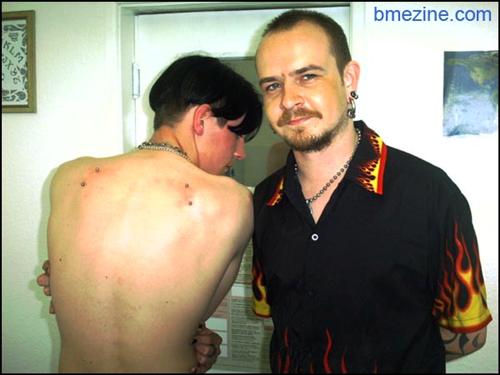 Sarge and Diddy during his Metal Fatigue days.
|
|
ROO: |
How do you improve your skills as a piercer?
|
|
DIDDY: |
I like to think that I’m always learning, if anyone knows me well they will tell you that I am stupidly over-critical of myself and my own work. I think this to be a good thing as I’m never happy with anything (that sounds a little silly), but I’m always on the lookout for better ways of doing everything. I know I’m not the best out there but one day I hope to be and you cannot do that without a little hard work and research. I do experiment a lot. I am in a position where I live with a considerable amount of modified people, who were always up for trying out something slightly different and new to me. Also as a part of BME and IAM I’m pretty much always lurking in forums picking up tips and chatting with other piercers on how and why they do the things they do. I like to think I’m also in good stead with other local artists such as Sarge, Gribbs, Bunty and a whole host of other Bournemouth IAM’ers. We share for the good of all.
|
|
ROO: |
Like the Piercing Musketeers, kinda. Are you an APP member? Why or why not?
|
|
DIDDY: |
There are many advantages with regards to being ‘in the know of the industry’, but I can’t stand political hype. Plus you can generally pick up the majority of the APP’s available information from other resources, minus the pecking order. I don’t and won’t cork every piercing. I do use canula/catheter needles and I don’t put elastic bands all over my instruments. I’m sure the APP is a wonderful organization and one day I will get around to applying for membership, but for now I am happy with the learning curve I am on.
|
|
ROO: |
A lot of piercers seem to move into scarification and implants in their later careers. Do you have an interest in this as well?
|
|
DIDDY: |
I started getting into implants a while ago, I did a few smaller basic pieces successfully and never really had a problem. But I decided to put that on hold until I had some sort of formal training. I decided that in retrospect I didn’t know what I was doing and the last thing I wanted to do was hurt anybody. So I stopped while everything was good. There is certainly formal training on the cards and I have already made plans to start working under somebody who’s work I really respect, but I won’t say too much about that as it’s still all in the pipeline. Scarification, specifically cutting is something I am definitely interested in. I have always loved the look and the effect of native and primitive scarification and I have always loved the look of scars in general, I get some weird looks from self-harming customers when I tell them I really like what they have done to themselves, not that I promote or condone self-harm. But I just can’t help being intrigued when I see a big set of self-made scars. I have been working really hard lately on getting myself together with the techniques involved with cutting and skin peeling. I don’t charge for the work that I do at the moment as I still feel that the outcome of each piece of work is more of a learning curve for me, when someone pays for scarification they are paying for your time, and a healed result, whereas at the moment I am giving my time to anyone who is willing to help me learn in perfecting my techniques and designs (to the point in which I feel I would personally pay to have work done by myself). Only then will I start to charge. 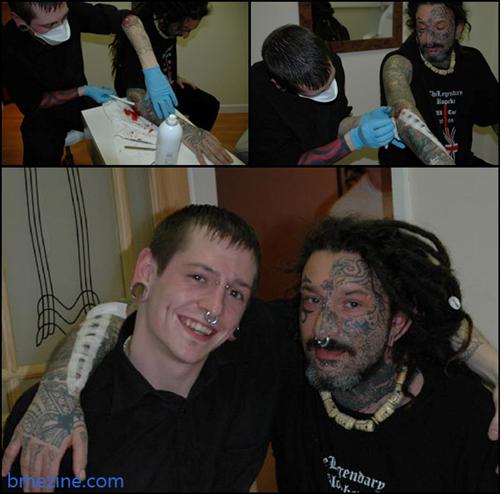 A happy customer, with seven PTFE domes!
|
|
ROO: |
What “secondary” education do you have on top of piercing knowledge (i.e. first aid, blood borne pathogen courses, etc.)?
|
|
DIDDY: |
Being a young gun I haven’t had much chance to do any of this yet, I have basic first aid training obviously, but I have signed myself up for GCSE physiology and anatomy to pave the way for college/university courses within the field, it’s difficult finding the time to work six days a week to keep myself afloat and to study at the same time, but determination will prevail there I think! My knowledge base comes from personal research. I have many friends in the medical field who are always happy to lend me material. My partner is currently training as a nurse and I am keeping an eye on the things that he’s doing to help myself along too. We have customers that are doctors and nurses, and obviously my partners friends are all willing to help and answer any questions I might have.
|
|
ROO: |
Do you think piercing is an art form or more of a craft?
|
|
DIDDY: |
I pondered on this question myself for a while never really coming to an appropriate answer. But since reading the article with Anders, and not to be cheeky and coin his comment but, ’I see piercing and modification as a craft you learn and become good at, but when it’s executed properly with well-placed piercings and jewelry, it can be an expression of art’, is exactly right! Most of the time I feel like I am providing my craft as a service to others, but every now and again I’ll put a mark on a client, not like it, and adjust it almost just a fraction to make it sit better (i.e. with the line of the face) or wherever it is, as I’m doing this I usually sit back and think ’now this is art!’
|
|
ROO: |
I’d be interested in hearing some of your best piercing client stories in terms of why people got piercings.
|
|
DIDDY: |
I don’t consider it my job to reason why people do what they do, and I don’t usually ask. Obviously clients like to talk about their reasoning and I must admit I do like to listen. I’ve heard it all, from weight gain, having a piercing to encourage weight loss, also the flip-side, someone who has lost weight wanting to congratulate themselves. Being close to a university I quite often get graduation and final exam piercings too. Divorce, marriage, birthdays, anniversaries, looking cool, I also deal with sub/dom stuff too. Basically any and every reason, I think I’ve heard it. From the smiley happy off your own back, to the bets with mates (I recently did a PA on a lad who was getting his tattoo all paid for if he had it done, needless to say he got himself a free tattoo) I think one of the sweetest things I’ve ever done has a bit of a long story to it, wanna hear that one?
|
|
ROO: |
Ugh, go on then!
|
|
DIDDY: |
Well a mother and daughter went in to get their navels pierced somewhere up country, the daughter went first and the mother backed out last minute, nothing was said but it was taken that the mother had to eventually get hers done as well. The daughter fell terminally ill and over the next few years her health deteriorated and sadly she passed away, the mother (a current tattoo customer) came to me with the daughters old navel bars and pointed at the daughters favourite and said I want this here for my daughter and pointed to her navel. I obviously couldn’t do it with that, but I used some of my own jewellery and about two months later she came in to see me with her daughter’s favourite piece of jewellery poking out of her navel, nicely healed. She carries her daughters love with her everywhere now and it seems to make her so happy and all I can do is quietly smile inside for making that happen. That rocks my world billions and that’s the kind of thing that makes me glad I do what I do. 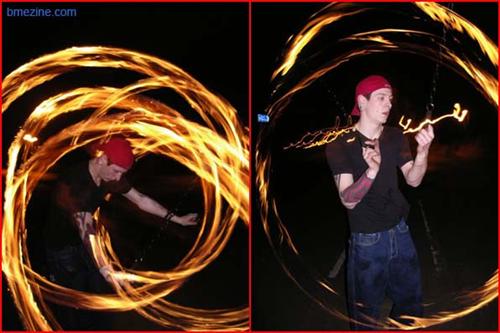 |
|
ROO: |
You’re such a sweetie. What are your favourite piercings to do, and why?
|
|
DIDDY: |
Every single piercing is different, both anatomically and characteristically. I wouldn’t even say two navels were the same piercing. I get half a feeling that it could be my age showing through there a little. I’m just as keen to do any piercing now as I always have been. I could say that given twenty years in the industry this could all change and I could start to develop a love for one specific piercing more than others, but given the fact that I know what being a jaded piercer can do to clients there is a high possibility that I will always love every single piercing I do, and put as much effort into every single customer as I always have!
|
|
ROO: |
That’s a good way of thinking sunshine, but, your least favourite?
|
|
DIDDY: |
The only piercings I don’t like doing are the ’I told you so’ piercings as I call them. When a customer walks into the shop knowing full well exactly what they want, I tell them either it’s not going to work or that I don’t think it’s going to look great and give them my reasons for thinking so.. Firstly I refuse to do the piercing and then they start talking about getting one of the local botch artists to do it.. this scares me more than a piercing which might not work out so well, to which I usually reply ’well if you’re adamant you want this doing I would rather make sure it was done safely and I will do it for you, but I want you to come back in on a regular basis so, i) I can make sure everything is going OK and, ii) to take it out when you hate it or when it starts looking bad. In this case it’s not so much the piercing I dislike as the customer, not listening to sound professional advice and I’m sure everybody out there, whatever industry they’re in, knows what it’s like to work with customers like this, it’s not fun.
|
|
ROO: |
Again, I know how you feel. What piercing do you find the most challenging?
|
|
DIDDY: |
Challenging piercings, hmmmm? I suppose something like pairing up someone else’s work has to be up there as challenging, it’s easy enough to pair up with a piercing that I’ve done as I generally know what angles I work at, but when I get something that’s done in such a way that I would not normally do it takes a little more thought and marking to get them looking the same. I’m talking about things like venoms/snakebites/double lip piercings, also things like multiple ear piercings. Some of the less challenging piercings in his portfolio. (click-throughs)
|
|
ROO: |
In general would you recommend piercing as a career? What advice would you give to someone who wants to become a piercer?
|
|
DIDDY: |
We all know that piercing isn’t the best paid job in the world! If you’re going to do it, you have to do it because you love it. There is no real way to ’make a quick pound or two’ so if you want to be rich and famous this definitely is the wrong career for you. On the other hand, if you love body piercing and everything that goes along with it, the good and the bad, then find yourself a good piercer and show that you are willing to learn and work hard for what you want to achieve. Do your research. Bad instruction is worse than no instruction at all!! It is unfortunate that the market is saturated with body piercers these days and a good apprenticeship is incredibly hard to find as all the best artists have theirs working already. You need to think if you can financially support yourself while you are apprenticing, usually a second job is a necessity as usually a piercer won’t pay someone to stand and watch, still living at home has its advantages in that case too, but saying that… I had neither when I started out in my career, so anything is possible!
|
|
ROO: |
Have you ever apprenticed anyone? How did you (or would you) choose one?
|
|
DIDDY: |
I do and I don’t. As I said earlier, I am always very critical of myself and my work. I don’t naturally feel as though I’m good enough in my own right to take on an apprentice (although I get told otherwise) and for them to be my prot’g’, for me to teach them every one of my little secrets.. I don’t work that way!!! But I do have someone who works for me assisting me with piercings, learning cross-contamination and sterilization, who watches a lot, if not all, of the piercings that I do. Picking up techniques and asking me questions on things that she doesn’t understand. If she also wants to pierce then I will be on-hand while she pierces her friends and builds herself up as a piercer in her own right, her name is Lily and she has been with me now for the last six months. I chose her for the twinkle I can see in her eye, HAHA, there is a certain something there that says to me ’I desperately want to pierce, can you help me?’ she was keen and bright and clean and tidy. Showed willingness and pretty much pestered me until I gave in. I see that as someone who will really love what they do right until the end. That is what I look for, not just a liking but a passion for piercing. Before Lily I did the same thing for a lad called Martin who got quite far with me… but in the end his passion burnt out and things went downhill. I sadly just couldn’t trust him anymore and had to stop him coming in which was a real shame. I enjoyed working with him and watching him bring himself into the industry quietly smiling to myself as things just twigged in his head, although I will never take credit for training anyone who is self-taught, it’s just nice to know that I helped him along. 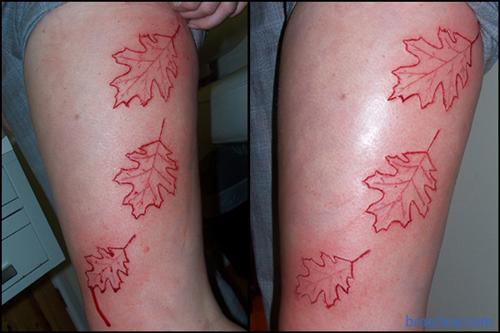 Diddy shoots, and leaves.
|
|
ROO: |
Do you think you’ll be able — or want — to do this for a living, long term?
|
|
DIDDY: |
Just try and stop me! I’ll be piercing until I can’t pierce any more, I can wholeheartedly say that until my body or the industry drastically fails me then I will keep poking holes in people.
|
|
ROO: |
Hehe, poking. If you leave piercing, what do you think you’ll do?
|
|
DIDDY: |
I think if I had to give up piercing for one reason or another, firstly I’d cry quite a bit, then not know what to do with myself for a while. I am not and never have been a guy that enjoys working for other people, I would probably set something up so that I can still work for myself and be who I want to be, maybe like a small caf’ or some sort of supplies company.
|
|
ROO: |
It’s been my observation that many piercers seem to “burn out” after five to ten years and leave the industry — what are some of the stresses of being a piercer?
|
|
DIDDY: |
I’d tend to disagree with your statement there, many of the piercers that I know and talk to have usually been in the industry for at least five years if not more and are still going very strong! I think the ones that burn out were probably doing it for the wrong reasons and weren’t so happy taking all the bad that comes with the good. Finding out all of a sudden that the money doesn’t get any better and pushing on with a career in something else, either that or they just get jaded and fed up with doing the same thing over and over and over and… well you get the picture. It is what you make of it, I don’t think it’s a very stressful job and I look forward to every day at work. If you see it as a job that you ’have’ to go to, you’re going to burn out very quickly!
|
|
ROO: |
What are the best things about being a piercer? What keeps you coming back to work?
|
|
DIDDY: |
Hahaha I love this question… Everything!!! I love making my clients smile, I love the job that I do, I love everything about the studio environment. I especially smile inside when I successfully rectify someone else’s fuck-ups. I just love people smiling and I really get a buzz out of giving someone something they’ve always wanted. I really like the way that customers walk in really nervous and scared but walk out buzzing.
|
|
ROO: |
Piercers seem to meet a lot “weirder” clients than tattoo artist… Tell me about some of your stranger encounters?
|
|
DIDDY: |
I’ve encountered so much weird in the last few years that anything I would have normally classed as weird doesn’t seem too bad anymore! For example, when I was first piercing I remember meeting a guy who had no nipples, they were removed by his mistress because she got so bored of the piercings that she made him have a few years previous. He was covered from the neck to the wrist to the ankles in small inch long white lines (scars) where she would mistreat him, that to me at the time was weird, but now that kind of thing just seems like any normal thing for consenting adults to do to each other. I think I find it more difficult to speak to ’normal’ people. I have much weirder conversations with a lot of the tattoo/piercing virgin customers who are new to all this and just have some sort of naivety as to what actually happens out there in this world.  |
|
ROO: |
What makes you a good piercer?
|
|
DIDDY: |
That’s not something that I could personally answer. I don’t think it’s down to me to call myself a good piercer. Everybody, even the hacks, would call themselves good piercers for one reason or another. If anyone wants to know what makes me a good piercer you should talk to someone that I’ve pierced. Though I do like to think I have an excellent bedside manner, the patience of a saint, and I actually give a damn about the things that I do.
|
|
ROO: |
What’s the youngest person you’ve ever pierced, and what’s your personal feeling on age (independent of the law)?
|
|
DIDDY: |
I have pierced lobes on babies, and I have to say I don’t like doing it. It’s actually something I will do if I have to but I will try as hard as I can to persuade a parent to wait until a child is old enough to have it done for themselves, I once met a young girl who had massive keloids on her ears, she’d had them from about two years old, when her parents had taken her to have her ears pierced and they hadn’t healed properly for whatever reason. This poor girl wouldn’t show her ears to anyone she was paranoid about being pierced and she was angry that her parents hadn’t given her the choice and that these things were forced upon her. I really felt for her and she had to have the keloids removed with an operation she had to pay for herself. I consider it almost along the lines as an abuse of power, a parent taking a baby to have their ears pierced, but at the end of the day it’s a bit of a catch-22 situation, if I don’t do it, its going to be a gun or the butcher down the road. Piercings are usually on sixteen year olds but I will go as low as fourteen with a legal parent or guardian in the room signing for them (with identification), but nothing lower than that for body piercing, it’s not right and I don’t like it. There is no way that anyone is developed enough under 14 to have any kind of piercing done. Even when a 14 year old comes in with a parent (normally for navel piercing) I advise them against it with the ’high chance of total migration’ theory and that’s usually enough to get them to wait until they’re a little older. What a poser!
|
|
ROO: |
And the oldest?
|
|
DIDDY: |
I think the sweetest thing I ever did was on an old couple I think he was about seventy and she was about sixty-eight. They both came in together after their 50th wedding anniversary to get their ear lobes pierced together (ROO: – Pierced together?! Now that’s commitment!), it was both their first time and we had such a laugh the lady ended up getting her hood done as well. I’ll always remember that couple and I still have the thank you card they sent me when everything healed perfectly.
|
|
ROO: |
What range of tools do you use? Needles? Scalpels? Dermal punches? More? Or anything past a needle, why or why not?
|
|
DIDDY: |
When I’d first started out I was using cannulas only, Sarge introduced me to the blade and to genital piercing so I started using blades and 2.4 cannulas, shortly after getting the hang of that I started using a few custom sized needles and found my preferences of length. I now use 1.2mm and 1.6mm blades and cannulas, as well as 2mm, 2.4mm , 3.2mm and 4mm blades for suspension piercing, and large gauge stuff. Once I’d done a few and enjoyed doing larger piercings I picked up some 4mm dermal punches, I really enjoyed using those, so I now stock 4mm, 5mm, 6mm and 8mm punches. When I started using those I also started using a scalpel to make larger piercings within the lobes as I really don’t like punching lobes out. I have tried using a scalpel for piercings but I think it’s a little excessive, you make lots of mess and it’s totally unnecessary and will never catch on with the public, that’s just my own opinion anyway.
|
|
ROO: |
What do you think of ear scalpelling?
|
|
DIDDY: |
I really enjoy it, I started off by expanding a friends tunnels, I can’t remember exactly from what size to what size, they were around the 20mm mark and we put them up to 30mm-ish, I believe. That was about two and a half years ago now, I did a couple of those and they all went really well. I do quite a bit of ’insta-tunnelling’ now, as I call it, I experimented about two years ago on a couple of friends doing 6mm and 8mm lobe piercings, they healed extremely well and I was really happy with the results, a few friends of theirs had seen them and wanted them doing, it started there really. I will now happily put anything in from scratch up to about 15mm. also I’m quite happy with expanding peoples existing lobes up by six or seven millimetres at a time. I would also really like to get into ear re-shaping, repair and lobe reconstruction, but again that’s something that I will have to wait for, more pipeline stuff!
|
|
ROO: |
What is your line as to what you won’t do? What’s your policy on doing “extreme” piercings like vertical oral piercings, under-the-collarbone, Achilles piercings, eyelids, banana hammocks, uvulas, and so on? If you don’t do these, why not?
|
|
DIDDY: |
I don’t like to draw lines in the sand, I’m usually willing to have a go at most things that come in and that I feel are safe. I will never do anything without the appropriate research (and technique practice if necessary). I really want to do a uvula piercing (I have even been practicing piercing on the end of a pair of hemostats) to be ready for if I’m asked, though I would only do the first couple on people I knew. If I’m ever unsure of anything I will not even attempt it, I will only touch someone if I know that everything I am doing is safe and will work out, it also depends on the customer and the situation. Depending on how much experience with piercing/modification they have and whether or not it’s a piercing I think, after research, is dangerous or not for me to perform. All customers are always fully aware of my abilities and experience in every single experimental procedure I perform. It’s as much as a learning curve for them as it is for me to do things like that.
|
|
ROO: |
How has the public attitude toward piercing changed in the time you’ve been working?
|
|
DIDDY: |
The only thing that I’ve really started to notice is parental acceptance, kids being brought in by their parents, even as young as twelve, parents are allowing their kids to get piercings done, not that I do them at that age of course but they seem to have more of a willingness to let their children do whatever they like. I have also noticed an increase in the amount of facial piercings on younger people, such as sixteen and seventeen year olds having facial surface work, septums, and mid-brows. I think it’s becoming more and more socially acceptable to have piercings, along with that comes professional acceptance. I remember when I was fifteen or sixteen and looking for part time work, nobody would employ you with your eyebrow or nose pierced and now it seems to be kind of the norm in most places. It’s great for the trade and I really like to see things picking up like it has. Bizzy Diddy! (click-throughs)
|
|
ROO: |
How do you feel about doing piercings that you’ve never had? Can you do them as well; give advice on them as well?
|
|
DIDDY: |
I’ve pretty much had and healed piercings all over my body, even if I didn’t like them and took them out pretty soon after, I know what it feels like to be pierced in most places. So I can relate to most customers, there are the odd one or two that I have never had and really don’t know how they feel, but knowing this I really try to get lots of feedback from my clients on how it felt, whether or not it met their expectations, how it healed and whether or not they had any kind of complication. I take a telephone number from each of my customers and regularly call up people who have had piercing work like this done to find out whether they had any issues, I then add all this information to the aftercare of the next one and so on. I’m pretty pleased to say this works and you can really get yourself a good feel for what kind of problems you can encounter even though not having had the piercing myself. Nasallang on the left and split-lobe piercing, 5mm conch punch and an 8mm outer flat punch on the right (GC). (click-throughs)
|
|
ROO: |
Are you still getting piercings yourself? I know a lot of people get a ton of piercings when they’re young, and then sort of “settle down”.
|
|
DIDDY: |
I’ve kind of turned into a bit of a jess. I’m not really piercing myself anymore I have what I want and I’m not going to get modified for the sake of it, if I need to check out a new technique or test out a new piece of jewellery I will of course try so on myself and see how things get on. But other than that I am happy with the piercings that I have, I’m working now on getting myself pretty heavily tattooed, when our tattooists have free time, which in general isn’t an awful lot. I agree with that statement though, I really have noticed that youngsters get pierced mainly, when they hit twenty/twenty-one they either carry on being pierced and get more and more heavily modified, either that or they stop around that age and either continue on with the piercings they have or just take them out altogether. There are exceptions to all rules but that’s definitely something that I have noticed.
|
|
ROO: |
Do you think piercing’s a trend? Is it getting more popular, is it starting to decline, or is it stable?
|
|
DIDDY: |
Due to the social and professional acceptance I think it’s just going to get more and more popular! I think parents are becoming aware that it’s not so much of a risky business anymore, and that obviously we are bound by local and government regulations so much that parents aren’t really as bothered now as they used to be. Obviously all it takes to change that is some really bad press with regards to someone doing something really silly and it could all come crashing down around our ears. I have certainly noticed a big increase in the amount of piercing work coming through the doors, but I suppose I will never really know how much of that is to do with reputation, or whether it’s just the trend building.
|
|
ROO: |
How do you feel piercing has changed over time?
|
|
DIDDY: |
Since I’ve been piercing I have noticed things like the quality of the jewellery just getting better and better, the techniques and methods being used have become a lot more refined and safer. Piercers themselves have become better informed and more educated. Also customers have become more aware of their rights to a clean and efficient piercer, customers are actually starting to do research into what they should expect from a piercer/piercing, which is always nice to see. I am really keen to see the next scientific step in body piercing. Hopefully one day someone will invent a machine to instantly heal piercings and trauma, that’ll be a day of great joy if that ever happens! I also hope I’m around long enough to see the piercing gun finally banned for good!!!
|
|
ROO: |
How did you get into doing scarification?
|
|
DIDDY: |
As I said earlier I’ve always loved the look of scars, when I started using scalpels at work, I also started thinking about making scarification pieces too. A couple of friends convinced me to start some small, light pieces on them. They turned out OK, but mostly they disappeared because I was afraid of working too deep. Over the course of the last year or so I have been working just slightly heavier every time until I get to the point where I am really happy with the depth that I work at, then I did a piece which looked like it needed to be peeled, as I was really just getting into proper scar work I had already done about as much research on the topic of peeling as I could possibly muster and went for it! The piece turned out OK, not brilliant, but practice was definitely needed there. The next piece I turned out was really nice and it all kind of went from there really. Cutting and flesh removal. (click-throughs)
|
|
ROO: |
How did you learn and refine your scarification work?
|
|
DIDDY: |
Being stuck in the south of the UK I never really got to see any serious work being done. So watching an artist work was out of the question, I offered free work to my friends as practice (which I still do) on the basis that they knew not only what work was available to them i.e. galleries on BME alongside my current portfolio of work (both good and bad). I am forever checking out work and lurking in IAM’s forums for ideas and new methods but I’m afraid to say, and I’m sure it will spark some controversy, when I say its mainly trial and error, to which all clients are fully informed of before I go anywhere near them. I like doing pieces which push me to try new things, always very lightly at first and then as my confidence builds in that specific technique I try to involve it in as much of my work as I possibly can. Although I’m not even a scratch on some of the top scarification artists out there, I’m still proud of what I have managed to achieve and all I can hope is that my work continues to improve to the point where I might one day feel comfortable actually charging for it (which I still don’t).
|
|
ROO: |
You’d make a rubbish bull. What types of scarification do you do?
|
|
DIDDY: |
Cutting and skin peeling only. I have a cautery/branding machine but I have never fired it up, that’s something I might try to incorporate when my cutting improves, for a different effect.
|
|
ROO: |
What is your artistic background? How do you do the designs?
|
|
DIDDY: |
I’m not the most fantastic of artist so coming up with complex designs is a little more difficult for me, but that’s OK, I don’t mind that so much as I really like basic bold designs. I’m very good at using Photoshop and working with the curvature of the body so I can bypass a lot of the difficulty in coming up with designs, I’m also trying really hard working on my freehand, I can usually be found sat drawing on people with no reason behind it at all other than getting used to free-handing and working with the correct lines of the body. 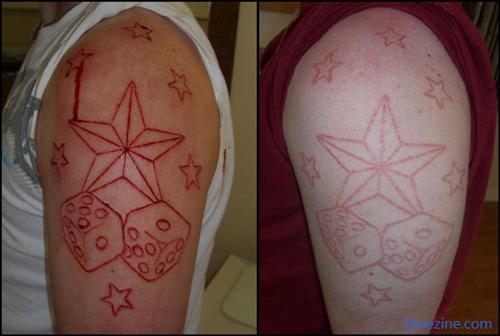 Freshly sliced, then nicely healed cutting by Diddy (from left to right, obviously).
|
|
ROO: |
Which types of scarification, and which types of images, do you most like doing, and why?
|
|
DIDDY: |
I really like to see a balance in work, it sounds a bit odd, but seeing something like a delicate flower or a smooth curve, with the contrast of the fact that it has been ’cut in’ in an almost aggressive fashion, it’s kind of ironic to me. I’m really not keen on heavy keloiding and try to keep my scars just that little bit lighter than that, and I love, just love, to see big bold scars, big bold patterns and designs, though I can understand that not everybody likes it that way and am also totally happy to work on more intricate designs, even if they take me some time to get ready in the first place.
|
|
ROO: |
Why do you think that most scarification artists come from a base of piercing, rather than tattooing?
|
|
DIDDY: |
Scalpels and heavier bleeding! Kinda seems more natural to come from a piercer than from a tattooist, though one of the tattooists here in our studio is watching a few of my pieces with the thought of working into it herself. I’m sure that it’s not all piercers working with scarification, but how many tattooists do you know that spend time working with scalpels. It’s almost like a natural progression for most piercers into their mods these days. Though I can certainly see why it could be better coming from a tattooist working with depth and consistency, those are some of the things that I was getting a lot of trouble with, now that I am doing more work it seems to be getting much easier to get a consistent depth and width from cutting than ever I used to. More from his “experimental” portfolio. (click-throughs)
|
|
ROO: |
How is your scarification client’le different from your piercing client’le?
|
|
DIDDY: |
Put simply, it’s not! Everyone I have ever cut, I have pierced. Mainly because I have friends heavily into their piercings, wanting something just that little bit different to a tattoo, either that or I am talking to someone who is a tattoo only man about doing some scarification over his tattoos. This would be the first person I will have cut without having a piercing by me too.
|
|
ROO: |
Do you do scarification commercially, or just on people you know? Why?
|
|
DIDDY: |
Ummm, that’s a toughy, I’m at the point now where I am happy that I am not going to hurt someone, so I am more than happy (within reason) to cut pretty much anybody that has seen my work and compared it to ’what they could be getting for money’, but, as I said earlier I’m not happy enough with the final results of my work to guarantee anything specific, so I will not charge for my time, in fact I don’t even charge for materials! I cover that all myself as a thank you for anyone who allows me to use their skin for refining my skills, I’m not in any kind of rush to start earning money from cutting, first and foremost I am and always will be a body piercer, so that pays the bills (most of the time). I will start commercially cutting people when I have decided that I would be happy enough to get and pay for a professional cutting done by myself. But tips for good work will never go amiss!
|
|
ROO: |
What do you think the future holds for scarification? Would you like to do it exclusively?
|
|
DIDDY: |
No, I will never stop piercing, it’s the passion of my life. It would be nice to think that someday I could swan around from place to place guest-spotting in different studios having work booked up for me, seeing the world and meeting lots of new people, but I think I would miss my little studio and my customers too much.
|
|
ROO: |
What are the laws in your area about scarification? What do you think they should be?
|
|
DIDDY: |
Bournemouth council doesn’t like it, they never have and I don’t think they ever will (though ’technically’ they just don’t have a stand on it). It’s not against the law, but our local council really likes to have control over what our piercers and tattooists are doing, scarification is something they just have no real knowledge or understanding of so it’s classed as a grey area. I think they should investigate and educate themselves a little more on the topic to allow us to work in this fashion without worrying about whether or not our registration is going to be revoked. Not that it’s likely to happen, it would be more of a polite finger waggle.
|
|
ROO: |
Have you had to deal with the media on piercing, scarification, suspension or other art forms?
|
|
DIDDY: |
I don’t like media, I don’t do interviews, I don’t like hype or fame. I’m sat here doing this interview because this is a community of my friends, and you asked me ever so politely. I know a lot of people here and most of them have no idea why I am doing what I do, or how I got into doing it. I’m not the best with words as you may have guessed by now and I have quite a lot of difficulty expressing myself this way, I also say things that I don’t mean to say when I’m trying to get a point across and that can cause upset if I am misinterpreted. I’m forever being asked to do interviews by university students for their course work and I politely refuse most of the time. Not really into bigging myself up because yes, at the end of the day I have a really cool job and yes, I understand certain people may look up to that but realistically I am a guy with a job just like everybody else. Being a piercer/artist makes you no different from a policeman walking a dangerous beat, I am nothing special, I just give a damn. Oh no, wait! I was once in the back of the local paper, ‘The Daily Echo’, in a small section I was asked if I like fish, to which my reply was ‘only fresh fish’ with a little photograph of me. I was so proud of that! 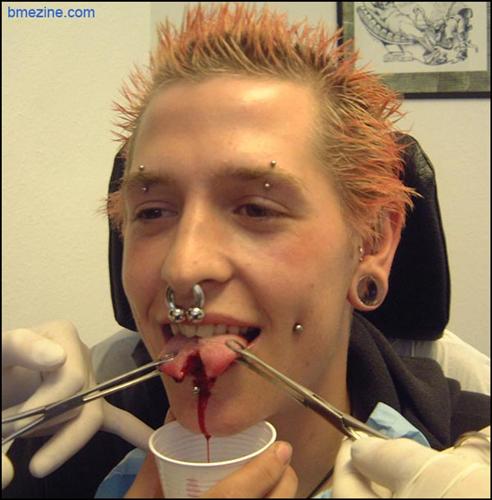 Not this photo!
|
|
ROO: |
Haha, bless. Well, on that rather fishy note I’ll leave you be Diddy Man, take care of yourself and good luck with everything! Lastly, big thanks to Rachel Anderson for allowing me to use her photographs in this article.
|
Click here to comment on this article (or use the comments forum below)
This article is copyright © 2008 bmezine.com, and for bibliographical purposes was first published April 29, 2008.
Please consider buying a membership to BME so we can continue bringing you articles like this one.
Please consider buying a membership to BME so we can continue bringing you articles like this one.
